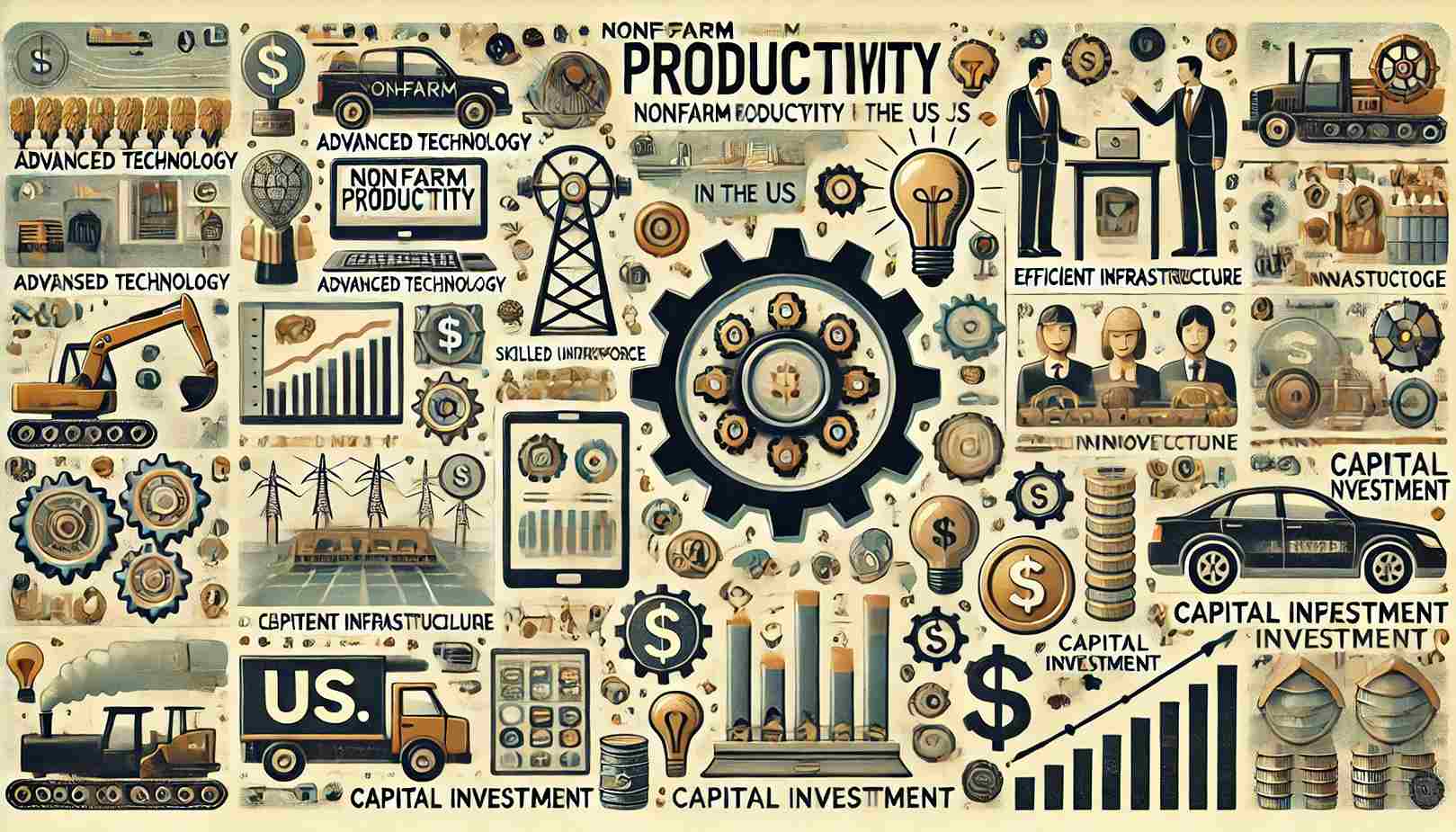US Nonfarm Productivity is one of those terms that you hear tossed around in economic discussions, but what does it really mean? How does it affect our daily lives, and why should you care? Let’s dive into this fascinating topic and uncover the layers of this economic indicator.
What is US Nonfarm Productivity?
US Nonfarm Productivity measures the efficiency of the American workforce, excluding the farming sector. It’s essentially how much output (goods and services) is produced per hour worked by nonfarm workers. This statistic is crucial because it reflects the overall health and efficiency of the economy.

Productivity gains often lead to higher wages, lower prices, and improved living standards. Think of it as the economy’s ability to do more with less. If productivity is rising, the economy can grow without causing inflation. Sounds important, right?
Why Exclude Farming?
You might wonder why farming is excluded from this measure. Farming is a highly volatile sector due to factors like weather, seasonal cycles, and international trade policies. Including it would skew the data, making it harder to get a clear picture of productivity trends in the broader economy.
Nonfarm productivity gives a more stable and accurate reflection of the overall economic performance. It’s like measuring your fitness progress without the inconsistent days when you had the flu or a bad night’s sleep.
How is Nonfarm Productivity Calculated?
The calculation of nonfarm productivity is straightforward but requires precise data. It involves dividing the total output of goods and services by the number of hours worked. The Bureau of Labor Statistics (BLS) is responsible for gathering this data and releasing quarterly reports.
Consider it like tracking your car’s fuel efficiency. If you know how much fuel you used and how many miles you traveled, you can determine how efficiently your car operates. Similarly, by knowing the total output and the hours worked, we can assess workforce efficiency.
Historical Trends in US Nonfarm Productivity
Historically, the US has experienced varying trends in productivity. The post-World War II era saw significant productivity gains, largely due to technological advancements and increased capital investment. However, there have been periods of stagnation, especially during economic downturns.
The 2008 financial crisis, for instance, led to a notable dip in productivity growth. However, the advent of new technologies and the rise of the gig economy have contributed to a resurgence in recent years. It’s like the ebb and flow of tides, constantly changing yet following a long-term trend.
Factors Influencing Nonfarm Productivity
Several factors influence nonfarm productivity. Technological advancements are a major driver, enabling workers to produce more in less time. Education and training also play a crucial role, equipping workers with the skills needed to operate efficiently.

Moreover, capital investment in machinery, infrastructure, and software boosts productivity by providing workers with better tools. Think of it as upgrading from a manual typewriter to a high-speed computer – the potential for increased output is enormous.
Impact of Nonfarm Productivity on the Economy
High productivity growth can lead to economic expansion without causing inflation. It can result in higher wages as businesses can afford to pay more due to increased output. Consumers benefit from lower prices, and the overall standard of living improves.
However, stagnant or declining productivity can lead to economic stagnation, lower wage growth, and higher inflation. It’s a bit like riding a bike uphill – when productivity is low, every pedal stroke feels harder, and progress is slower.
Nonfarm Productivity and Monetary Policy
Nonfarm productivity is a key factor considered by the Federal Reserve when setting monetary policy. If productivity is rising, the economy can grow faster without triggering inflation, allowing the Fed to keep interest rates lower.
Conversely, if productivity is lagging, the Fed might raise interest rates to prevent overheating and inflation. It’s like adjusting the thermostat in your home – finding the right balance is crucial for comfort.
Technological Advancements and Productivity
Technological advancements are perhaps the most significant driver of productivity gains. Innovations such as automation, artificial intelligence, and advanced manufacturing techniques enable workers to produce more with less effort.
For instance, consider how email has revolutionized communication in the workplace. What used to take days via postal mail now happens in seconds. This dramatic increase in efficiency is a clear example of how technology boosts productivity.
The Role of Education and Training
Education and training are vital components of productivity growth. A well-educated workforce can adapt to new technologies and methods more quickly, leading to greater efficiency. Continuous training ensures that workers’ skills remain relevant in an ever-changing job market.

Imagine trying to fix a car without knowing how it works – education and training provide the necessary knowledge to perform tasks effectively and efficiently, driving productivity forward.
Capital Investment and Productivity
Capital investment in infrastructure, machinery, and technology is essential for productivity growth. When businesses invest in state-of-the-art equipment, they enable workers to produce more in less time, thus boosting productivity.
Think of it as upgrading from a bicycle to a car – the potential for covering more distance in less time is vastly increased, reflecting the impact of capital investment on productivity.
Challenges to Productivity Growth
Despite its importance, several challenges can hinder productivity growth. These include economic downturns, political instability, and inadequate infrastructure. Additionally, a mismatch between workers’ skills and job requirements can also impede productivity.
Consider it like trying to bake a cake without the right ingredients – no matter how skilled you are, the outcome will be suboptimal if you don’t have what you need. Similarly, productivity growth requires the right conditions and resources.
Future Outlook for US Nonfarm Productivity
The future of US nonfarm productivity looks promising, with ongoing technological advancements and increasing capital investment. However, it’s crucial to address challenges such as education and training gaps to sustain long-term growth.

As we move forward, maintaining a focus on innovation, education, and investment will be key to unlocking the full potential of the US workforce. It’s like planting seeds in fertile soil – with the right care and attention, the harvest can be bountiful.
Conclusion
US Nonfarm Productivity is a vital indicator of economic health, reflecting the efficiency and capability of the American workforce. From technological advancements to education and capital investment, various factors drive productivity growth, impacting wages, prices, and living standards.
Understanding and improving nonfarm productivity is essential for fostering economic prosperity and ensuring a high quality of life for all. As we look to the future, addressing challenges and leveraging opportunities will be key to sustaining productivity growth and economic success.
FAQs
What is the significance of US Nonfarm Productivity?
US Nonfarm Productivity measures the efficiency of the American workforce, excluding farming. It’s crucial for understanding economic health, wage growth, and living standards.
How is nonfarm productivity calculated?
Nonfarm productivity is calculated by dividing the total output of goods and services by the number of hours worked, giving a measure of output per hour.
Why is farming excluded from nonfarm productivity?
Farming is excluded due to its high volatility caused by factors like weather and seasonal cycles, which can skew overall productivity data.
What factors influence nonfarm productivity?
Key factors include technological advancements, education and training, and capital investment in machinery and infrastructure.
How does nonfarm productivity impact monetary policy?
Nonfarm productivity influences the Federal Reserve’s monetary policy decisions. High productivity growth can allow for lower interest rates, while low productivity might necessitate higher rates to control inflation.
